

Visit 2010
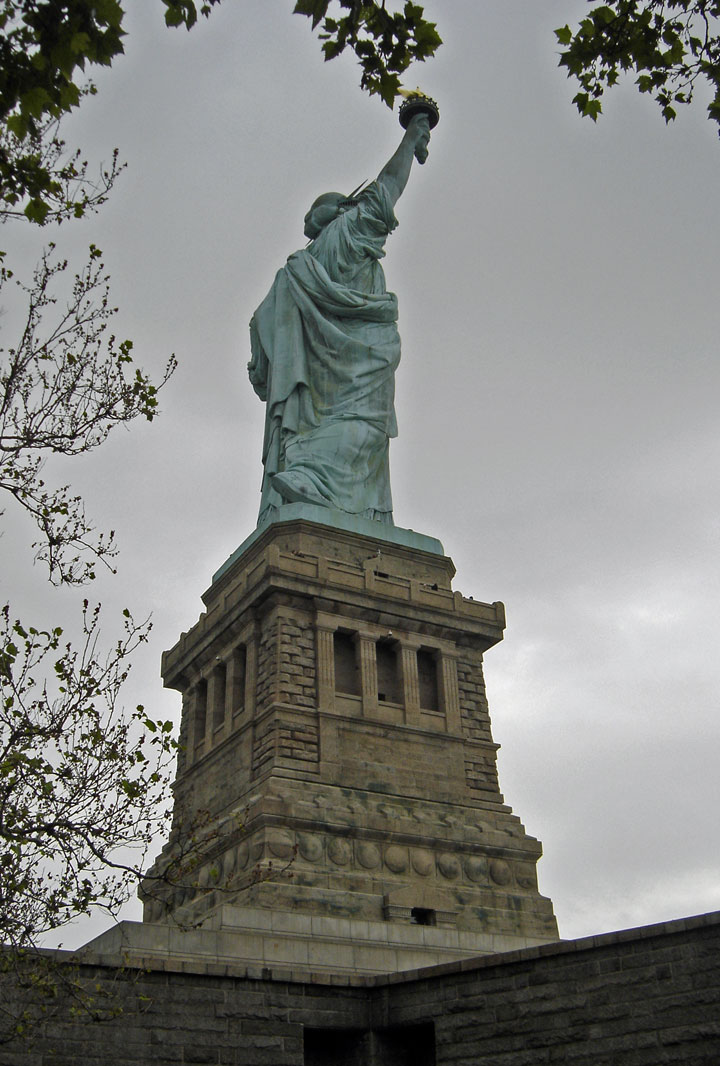
Statue of Liberty
The Statue of Liberty (French: Statue de la Liberté), officially titled Liberty Enlightening the World (French: la Liberté éclairant le monde), dedicated on October 28, 1886, is a monument commemorating the centennial of the signing of the United States Declaration of Independence, given to the United States by the people of France to represent the friendship between the two countries established during the American Revolution. It represents a woman wearing a stola, a radiant crown and sandals, trampling a broken chain, carrying a torch in her raised right hand and a tabula ansata, where the date of the Declaration of Independence JULY IV MDCCLXXVI is inscribed, in her left arm. Standing on Liberty Island in New York Harbor, it welcomes visitors, immigrants, and returning Americans traveling by ship. Frédéric Auguste Bartholdi sculpted the statue and obtained a U.S. patent for its structure. Maurice Koechlin—chief engineer of Gustave Eiffel's engineering company and designer of the Eiffel Tower—engineered the internal structure. The pedestal was designed by architect Richard Morris Hunt. Eugène Viollet-le-Duc was responsible for the choice of copper in the statue's construction, and for the adoption of the repoussé technique, where a malleable metal is hammered on the reverse side.

The statue is made of a sheathing of pure copper, hung on a framework of steel
(originally puddled iron) with the exception of the flame of the torch, which is
coated in gold leaf (originally made of copper and later altered to hold glass
panes). It stands atop a rectangular stonework pedestal with a foundation in the
shape of an irregular eleven-pointed star. The statue is 151 ft (46 m) tall, but
with the pedestal and foundation, it is 305 ft (93 m) tall.
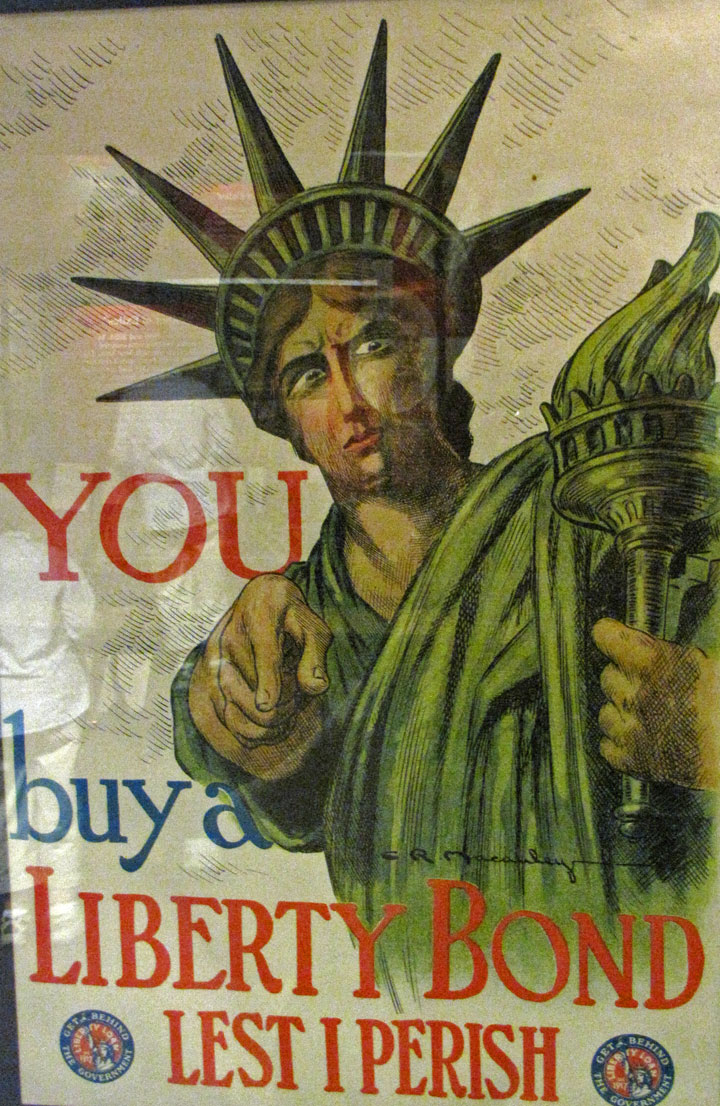
The Statue of Liberty is one of the most recognizable symbols in the world, and
of the United States. For many years it was one of the first glimpses of the
United States for millions of immigrants and visitors after ocean voyages from
around the world.
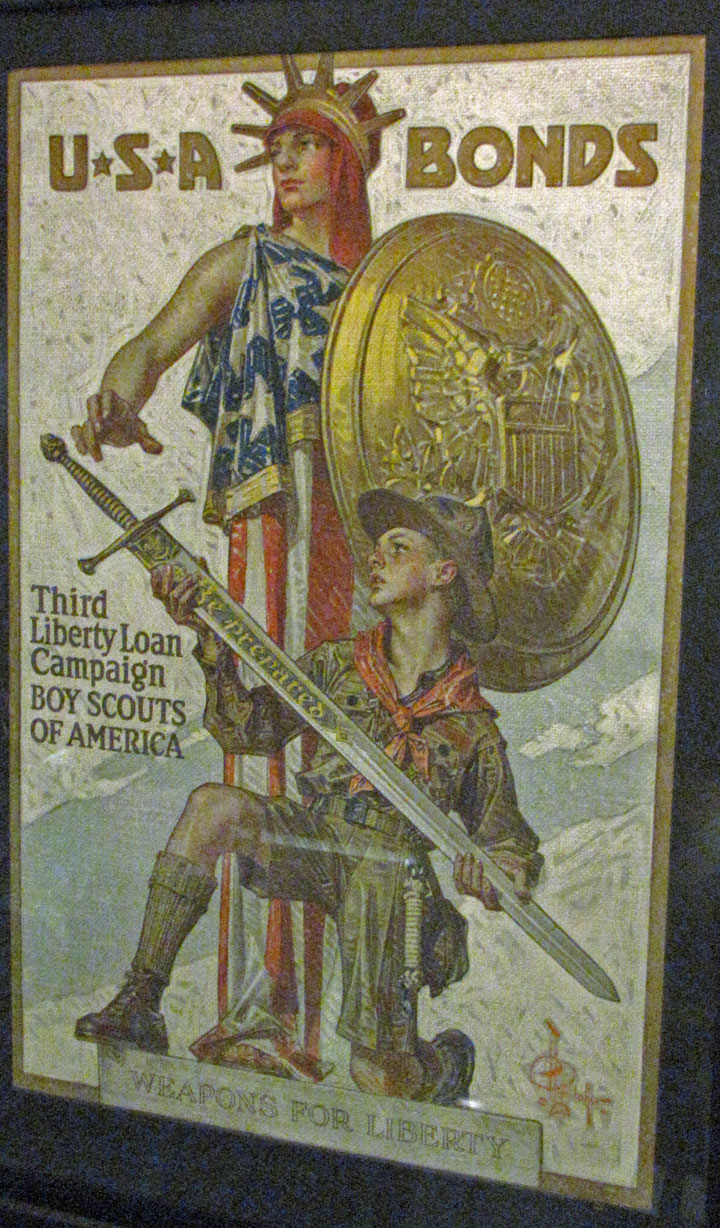
The statue is the central part of Statue of Liberty National Monument,
administered by the National Park Service. The National Monument also includes
Ellis Island.
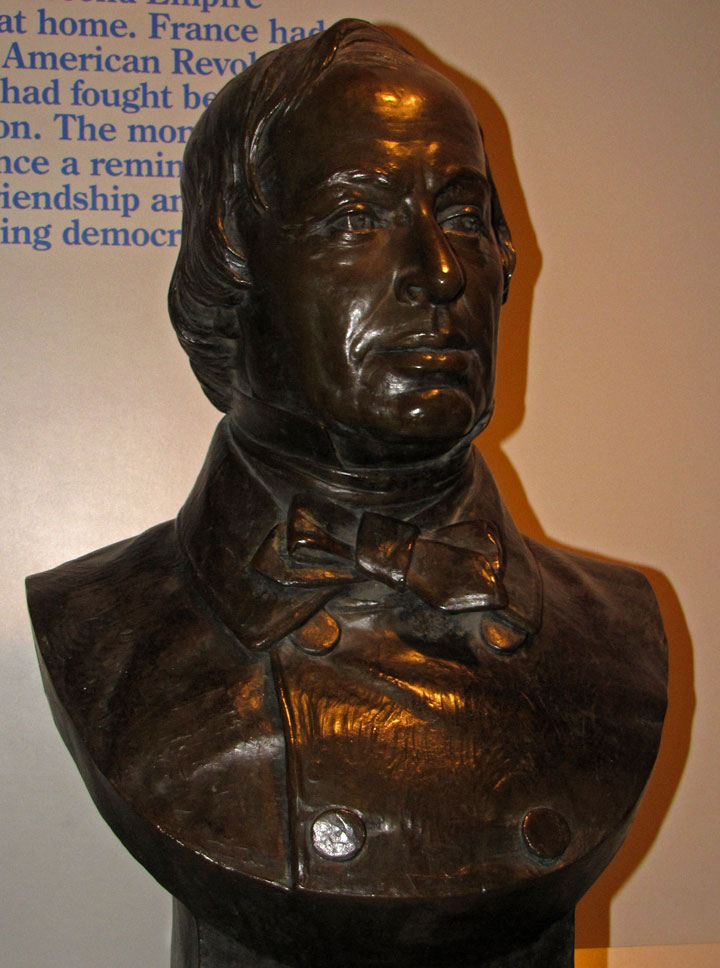
Edouard de Laboulaye

Discussions in France over a suitable gift to the United States to mark the
Centennial of the American Declaration of Independence were headed by the
politician and sympathetic writer of the history of the United States, Édouard
René de Laboulaye. French sculptor Frédéric Bartholdi was commissioned to design
a sculpture with the year 1876 in mind for completion. The idea for the
commemorative gift then grew out of the political turmoil which was shaking
France at the time. The French Third Republic was still considered as a
temporary arrangement by many, who wished a return to monarchism, or to some
form of constitutional authoritarianism such as they had known under Napoleon.
The idea of giving a colossal representation of republican virtues to a sister
republic across the sea served as a focus for the republican cause against other
politicians.

The first small terracotta model was created in 1870. It is now exhibited at the
Musée des beaux-arts de Lyon. The first reduced scale bronze replica was given
to the city of Paris by Americans residing in the French capital on May 13,
1885; the statue was originally located in the Place des États-Unis and was
moved to the Île des Cygnes in 1889.
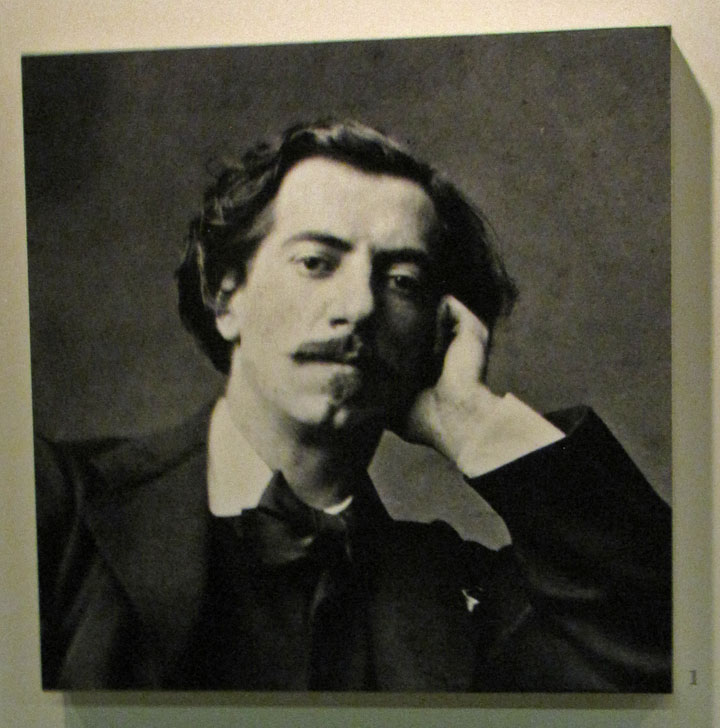
Frédéric Auguste Bartholdi
While on a visit to Egypt that was to shift his artistic perspective from simply grand to colossal, Bartholdi was inspired by the project of the Suez Canal which was being undertaken by Count Ferdinand de Lesseps, who later became a lifelong friend of his. He envisioned a giant lighthouse standing at the entrance to the canal and drew plans for it. It would be patterned after the Roman goddess Libertas, modified to resemble a robed Egyptian peasant, with light beaming out from both a headband and a torch thrust dramatically upward into the skies. Bartholdi presented his plans to the Egyptian Khedive, Isma'il Pasha, in 1867 and, with revisions, again in 1869, but the project was never commissioned because of financial issues then troubling the Ottoman Empire.
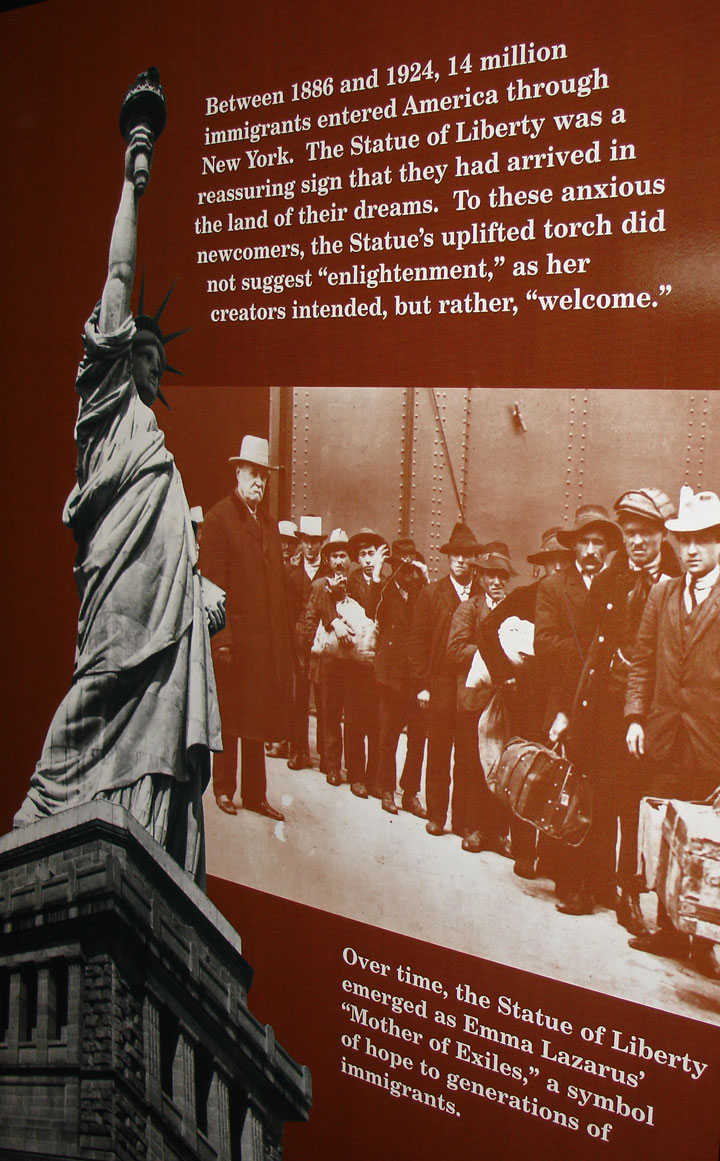
It was agreed that in a joint effort, the people of the United States were to
build the base, and the French people were responsible for the statue and its
assembly in the States. In France, public donations, various forms of
entertainment including notably performances of La liberté éclairant le monde
(Liberty enlightening the world) by soon-to-be famous composer Charles Gounod at
Paris Opera, and a charitable lottery were among the methods used to raise the
2,250,000 francs ($250,000). In the United States, benefit theatrical events,
art exhibitions, auctions and prize fights assisted in providing needed funds.

Meanwhile in France, Bartholdi required the assistance of an engineer to address
structural issues associated with designing such a colossal copper sculpture.
Gustave Eiffel (designer of the Eiffel Tower) was commissioned to design the
massive iron pylon and secondary skeletal framework which allows the statue's
copper skin to move independently yet stand upright. Eiffel delegated the
detailed work to his trusted structural engineer, Maurice Koechlin.
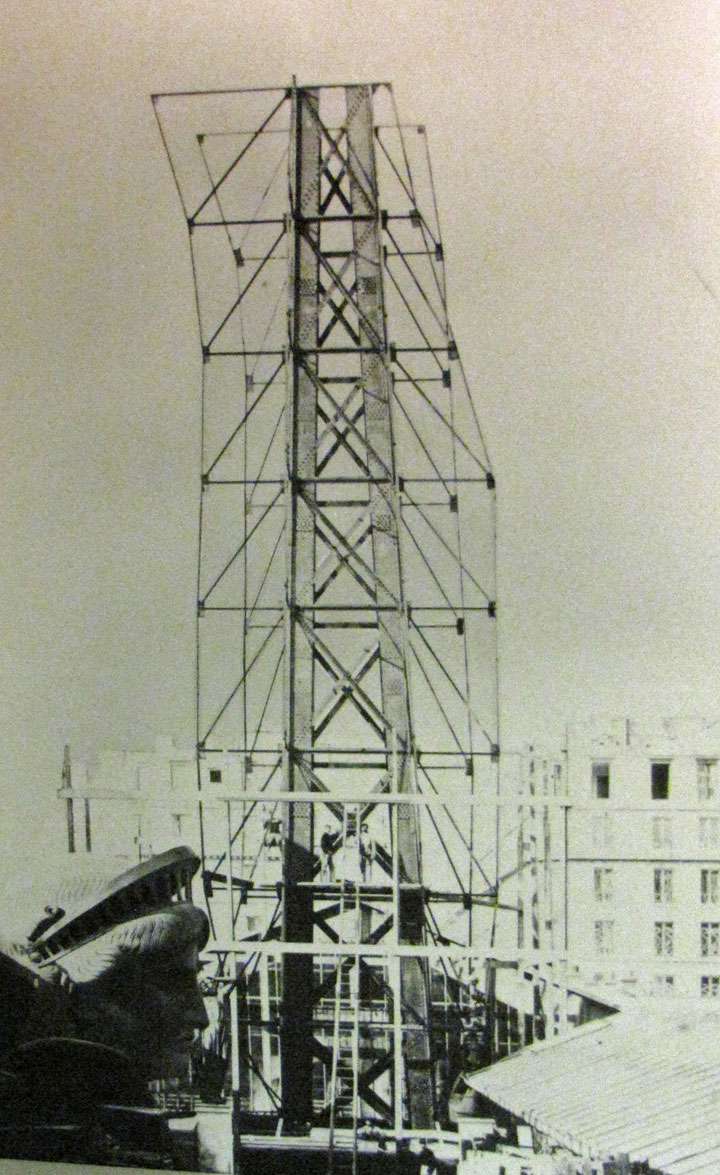
Eiffel's framwork
Bartholdi had initially planned to have the statue completed and presented to the United States on July 4, 1876, but a late start and subsequent delays prevented it. However, by that time the right arm and torch were completed. This part of the statue was displayed at the Centennial Exposition in Philadelphia, where visitors were charged 50 cents to climb the ladder to the balcony. The money raised this way was used to start funding the pedestal.
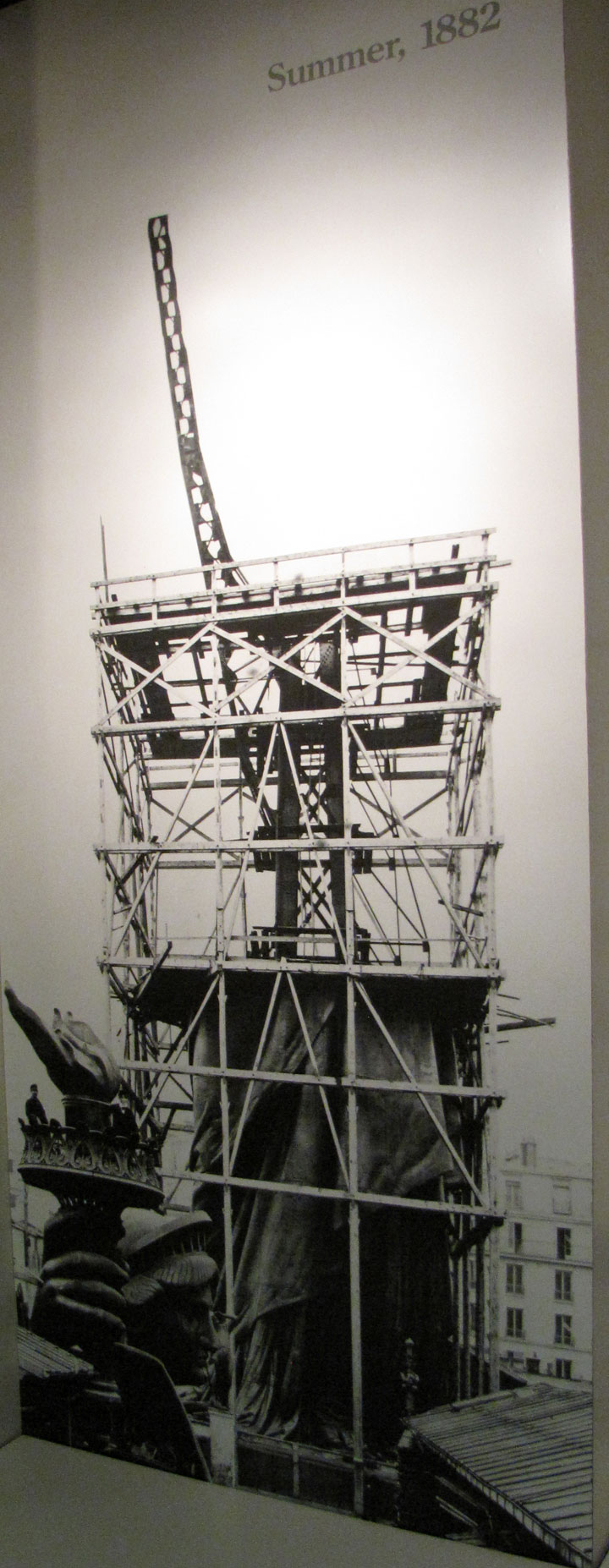
1882
On June 30, 1878, at the Paris Exposition, the completed head of the statue was showcased in the garden of the Trocadéro Palace, while other pieces were on display in the Champ de Mars.

1883
Back in the United States, the site, authorized in New York Harbor by an Act of Congress on March 3, 1877, was selected by General William Tecumseh Sherman, who settled on Bartholdi's own choice, then known as Bedloe's Island (named after Isaac Bedloe), where there was already an early 19th century star-shaped fortification named Fort Wood. United States Minister to France Levi P. Morton hammered the first nail in the construction of the statue in Paris on October 24, 1881.
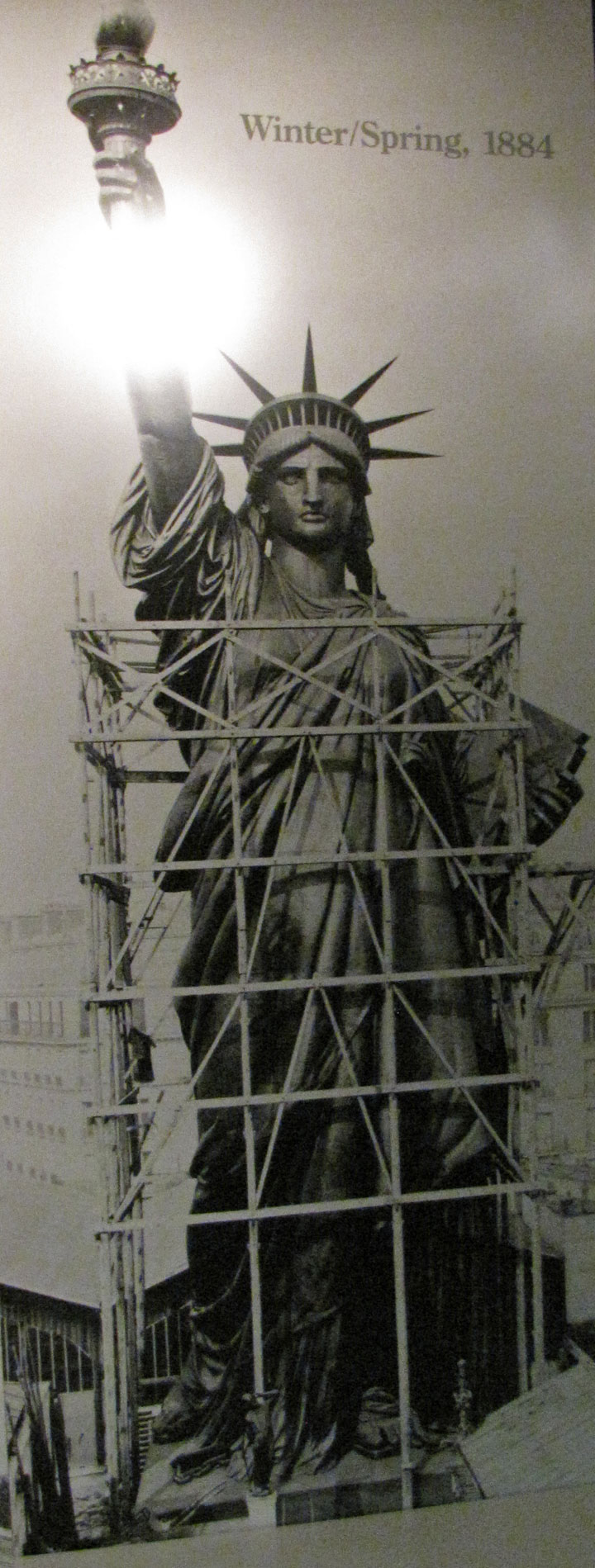
1884
On February 18, 1879, Bartholdi was granted a design patent, U.S. Patent D11,023, on "a statue representing Liberty enlightening the world, the same consisting, essentially, of the draped female figure, with one arm upraised, bearing a torch, and while the other holds an inscribed tablet, and having upon the head a diadem, substantially as set forth." The patent described the head as having "classical, yet severe and calm, features," noted that the body is "thrown slightly over to the left so as to gravitate upon the left leg, the whole figure thus being in equilibrium," and covered representations in "any manner known to the glyptic art in the form of a statue or statuette, or in alto-relievo or bass-relief, in metal, stone, terra-cotta, plaster-of-Paris, or other plastic composition."
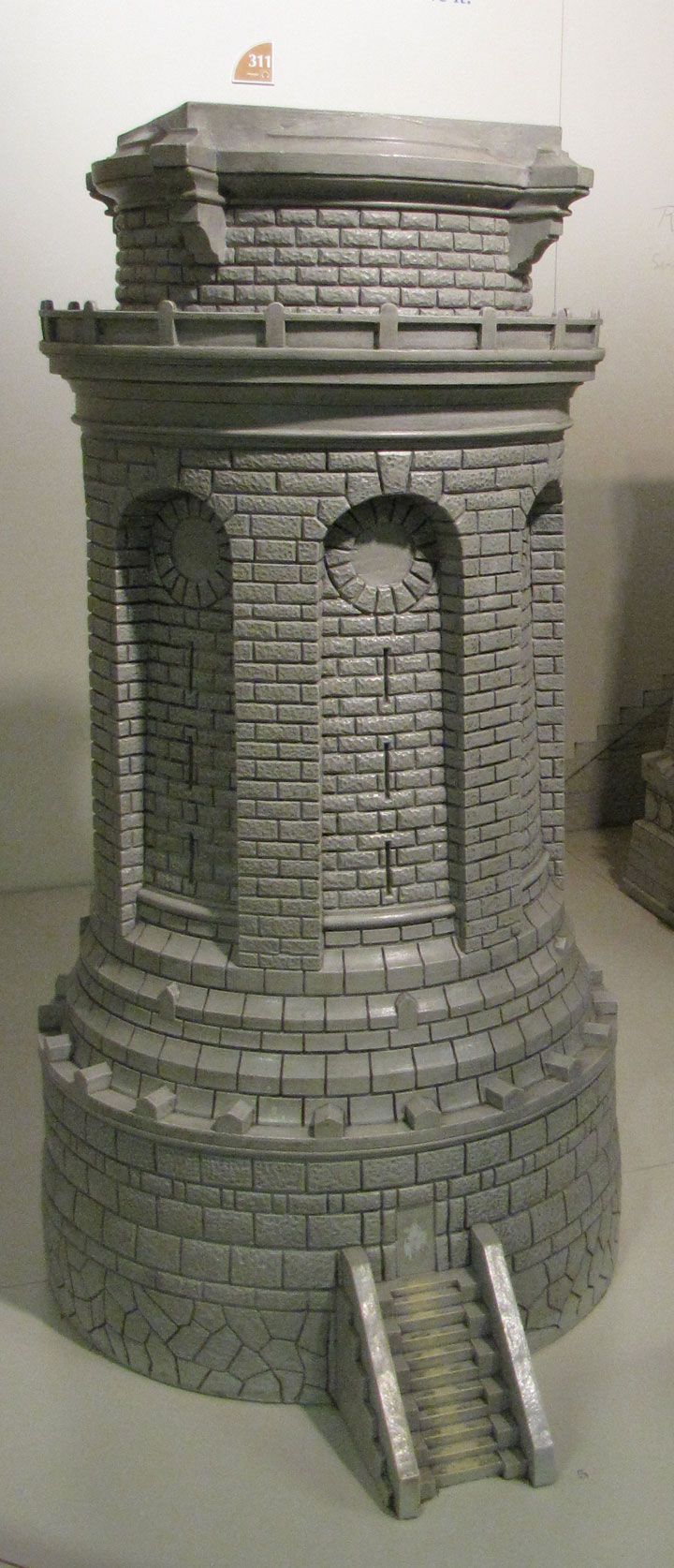
one pedestal design
The financing for the statue was completed in France in July 1882. Fund-raising for the pedestal, led by William M. Evarts, proceeded slowly, so publisher Joseph Pulitzer (who established the Pulitzer Prize) opened up the editorial pages of his newspaper, The World, to support the fund raising effort in 1883. Pulitzer used his newspaper to criticize both the rich, who had failed to finance the pedestal construction, and the middle class who were content to rely upon the wealthy to provide the funds. His campaign was an important contribution to the effort, but ultimately Senator Evarts and the American Committee he headed raised the majority of funds for the pedestal.

pedestal design
The construction of the statue was completed in France in July 1884. The cornerstone of the pedestal, designed by American architect Richard Morris Hunt, was laid on August 5, 1884, but the construction had to be stopped by lack of funds in January 1885. It was resumed on May 11, 1885 after a renewed fund campaign by Joseph Pulitzer in March 1885. Thirty-eight of the forty-six courses of masonry were yet to be built.

cornerstone
The statue arrived in New York Harbor on June 17, 1885, on board the French frigate Isère commanded by Lespinasse De Saune. To prepare for transit, the Statue was reduced to 350 individual pieces and packed in 214 crates. (The right arm and the torch, which were completed earlier, had been exhibited at the Centennial Exposition in Philadelphia in 1876, and thereafter at Madison Square in New York City.) Joseph Henderson was expressly selected to escort the French Steamer into the New York Harbor to Bedloe's Island. This event and Pilot Henderson's appearance was printed in The New York Times: "Old Pilot Henderson, who jumped from the skylight down on the quarter deck of the Isère."
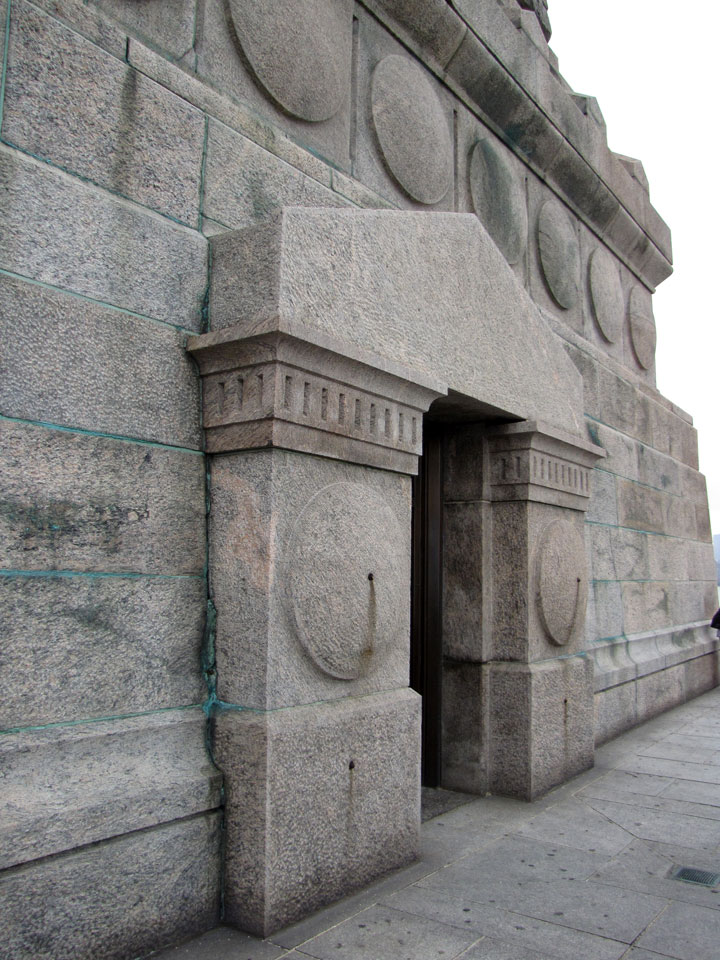
the pedestal

Financing for the pedestal was completed on August 11, 1885 and construction was finished on April 22, 1886. When the last stone of the pedestal was swung into place the masons reached into their pockets and showered into the mortar a collection of silver coins.
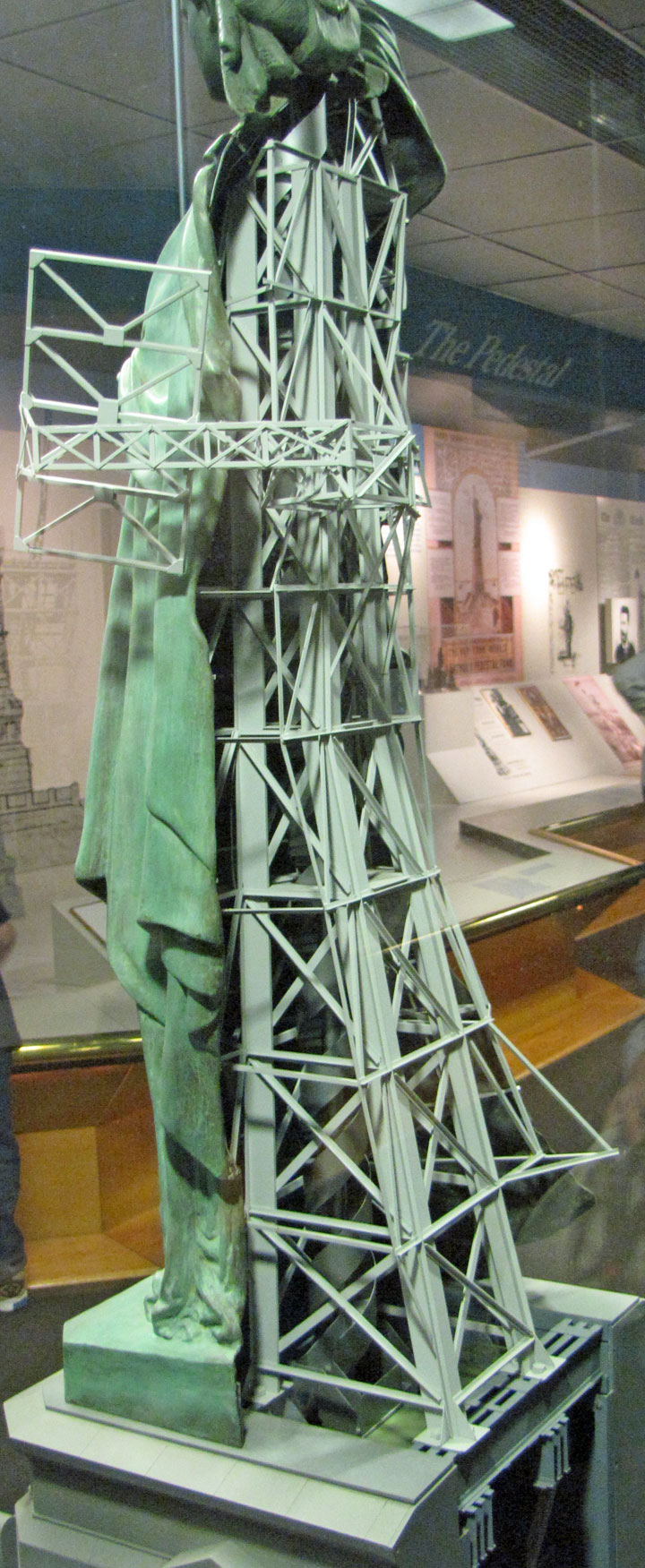
steel framework within the statue
Built into the pedestal's massive masonry are two sets of four iron girders, connected by iron tie beams that are carried up to become part of Eiffel's framework for the statue itself. Thus, Liberty is integral with her pedestal. Used as a lighthouse, the original torch fatally disoriented birds.
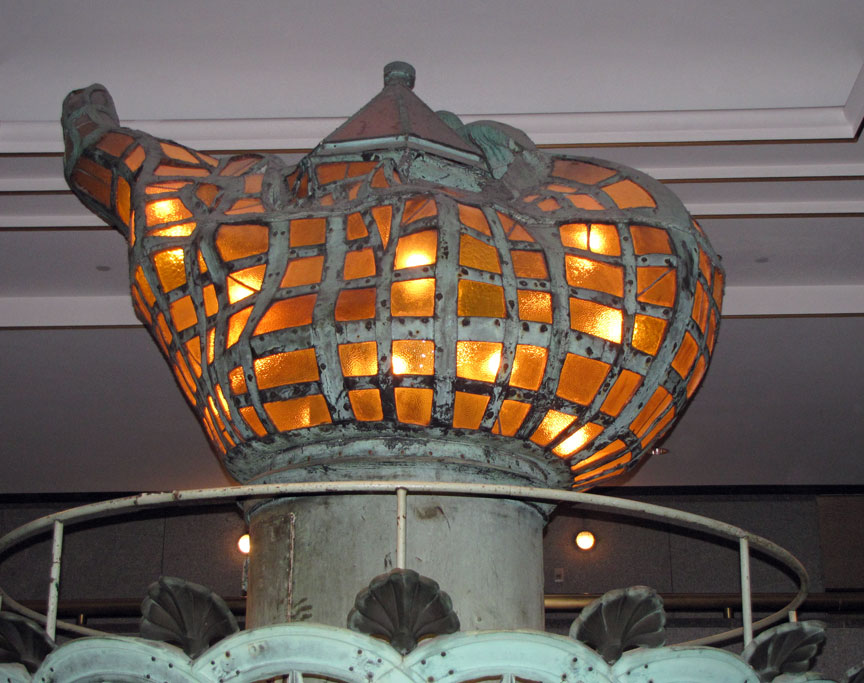
previous lamp
The statue, which was stored for eleven months in crates waiting for its pedestal to be finished, was then reassembled in four months. On October 28, 1886, the Statue of Liberty was unveiled by President Grover Cleveland in front of thousands of spectators. (Cleveland, as Governor of the State of New York, had earlier vetoed a bill by the New York legislature to contribute $50,000 to building of the pedestal.)
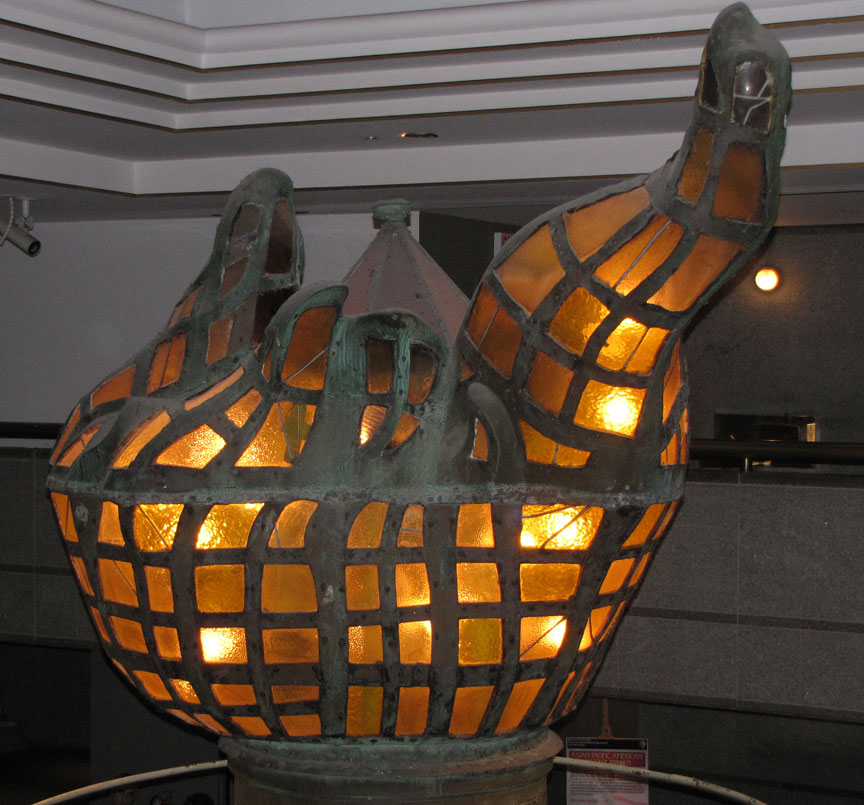
Nearly 10 years after the Statue of Liberty was assembled, the United States
donated $10,000,000 USD (adjusted for inflation) to various charities in France.
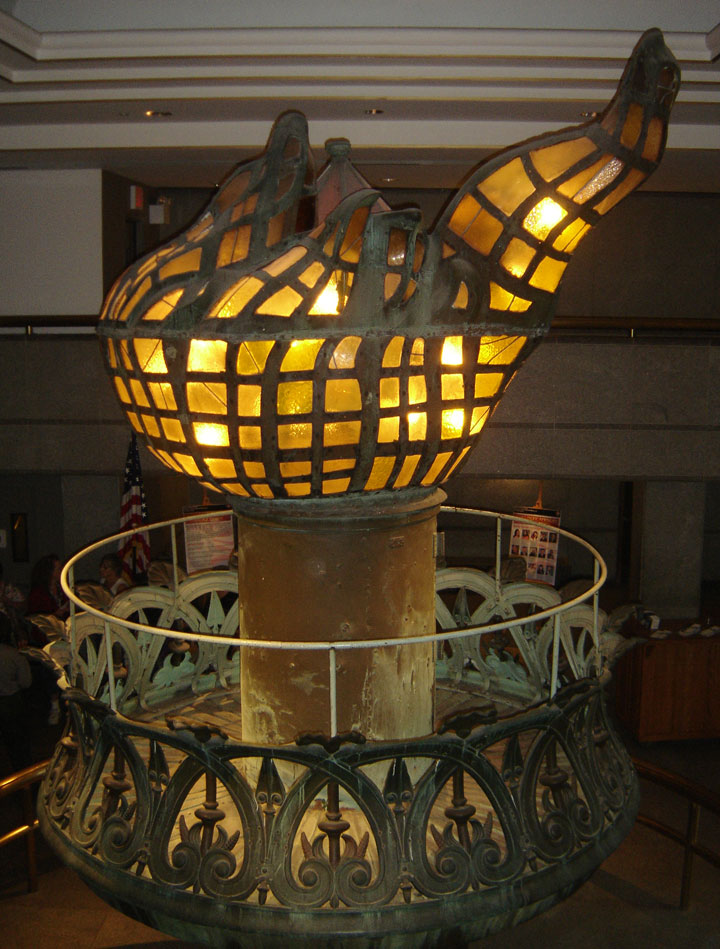
The Statue of Liberty functioned as a lighthouse from 1886 to 1902. At that time
the U.S. Lighthouse Board was responsible for its operation. There was a
lighthouse keeper and the electric light could be seen for 24 miles (39 km) at
sea. As a lighthouse, it is the first in the United States to use electricity;
there was also an electric plant on the island to generate power for the light.


Wilbur Wright was the first person to fly an airplane around the statue, at
waist level, a feat he performed on September 29, 1909 during the Hudson-Fulton
Celebration.

Pedestal Fund
In 1913 a group of young pilots were graduated from the Moisant school of aviation based on Long Island. One of the graduates, the Mexican pilot Juan Pablo Aldasoro was selected to perform the first flight above the statue. All of the graduates later on became members of the Early Birds of Aviation.
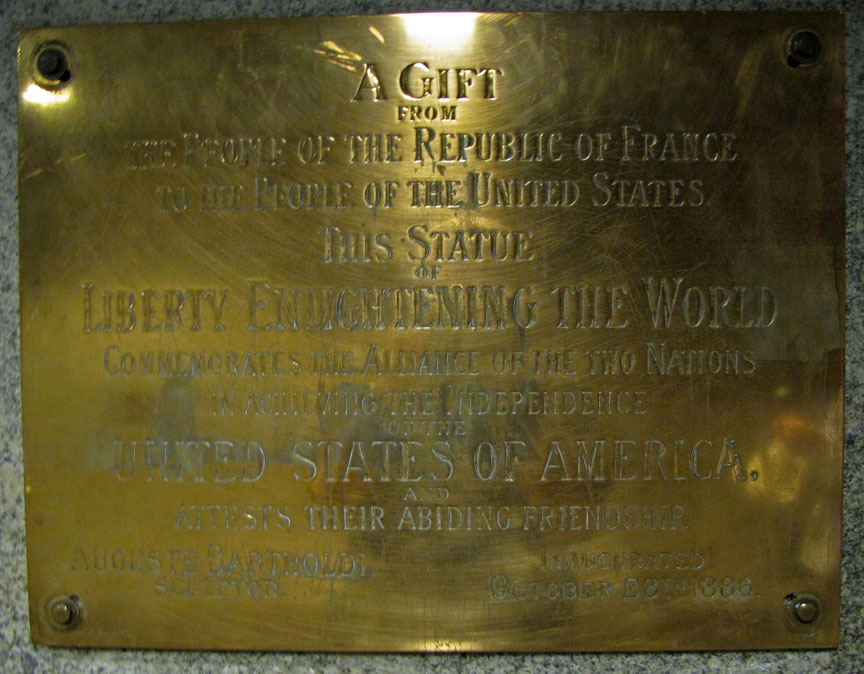
Gift from France
In 1916, floodlights were placed around the base of the statue. Also in 1916, the Black Tom explosion caused $100,000 worth of damage ($1.98 million in 2008 dollars) to the statue, embedding fragmentation and eventually leading to the closing of the torch to visitors. The same year, Gutzon Borglum, sculptor of Mount Rushmore, modified the original copper torch by cutting away most of the copper in the flame, retrofitting glass panes and installing an internal light. After these modifications, the torch severely leaked from rainwater and snow melts, accelerating corrosion inside the statue. President Franklin D. Roosevelt rededicated the Statue of Liberty on its Fiftieth anniversary (October 28, 1936).
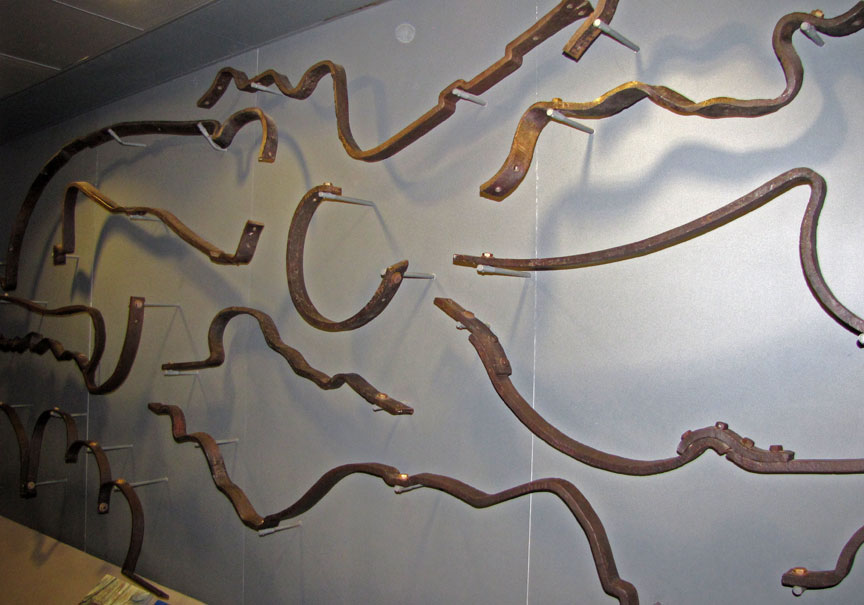
straps holding the copper to the framework
In 1956, through an Act of Congress, Bedloe's Island was officially renamed Liberty Island, although Liberty Island had been used informally since the turn of the century.
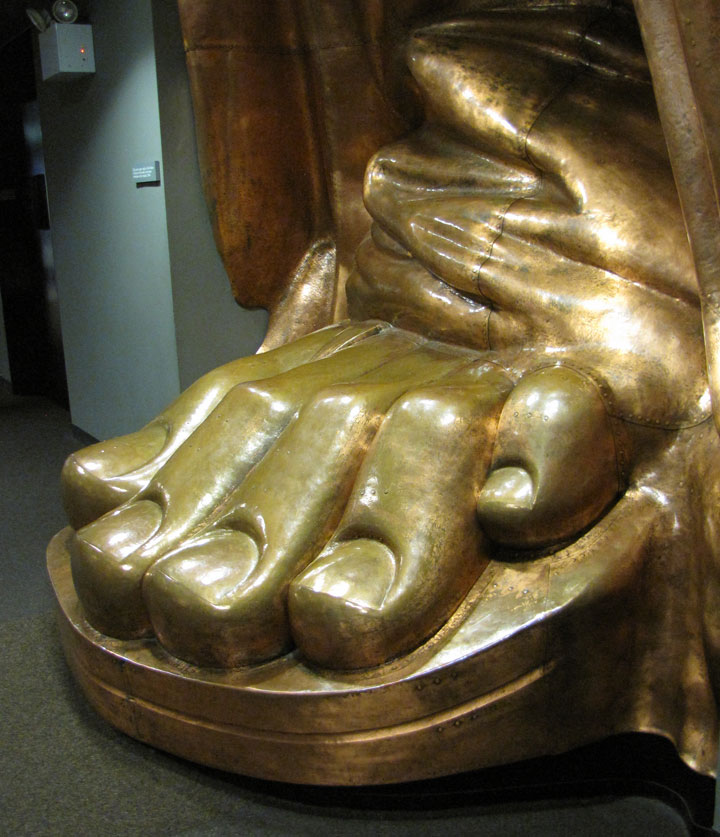
statue toes
As with all historic areas administered by the National Park Service, Statue of Liberty National Monument, along with Ellis Island and Liberty Island, was listed on the National Register of Historic Places on October 15, 1966.
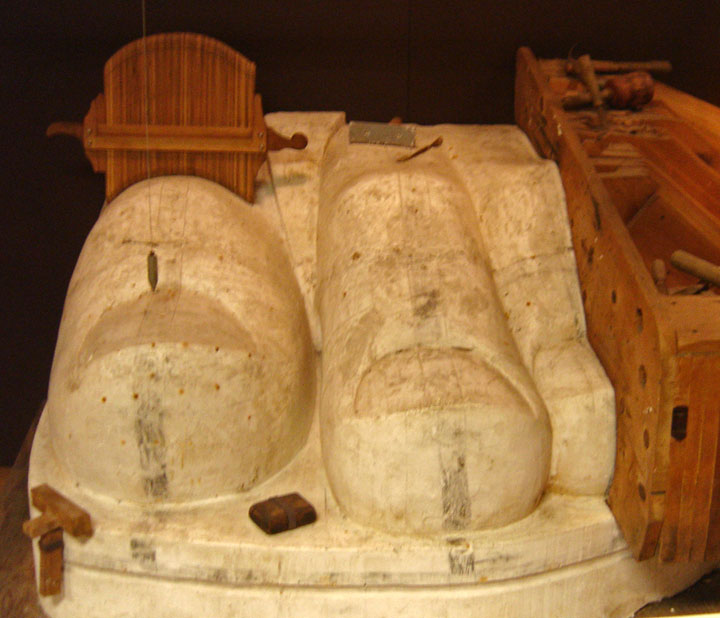
toe mold
In 1972, President Richard M. Nixon dedicated the American Museum of Immigration, housed in structural additions to the base of the pedestal on top of what was Fort Wood.
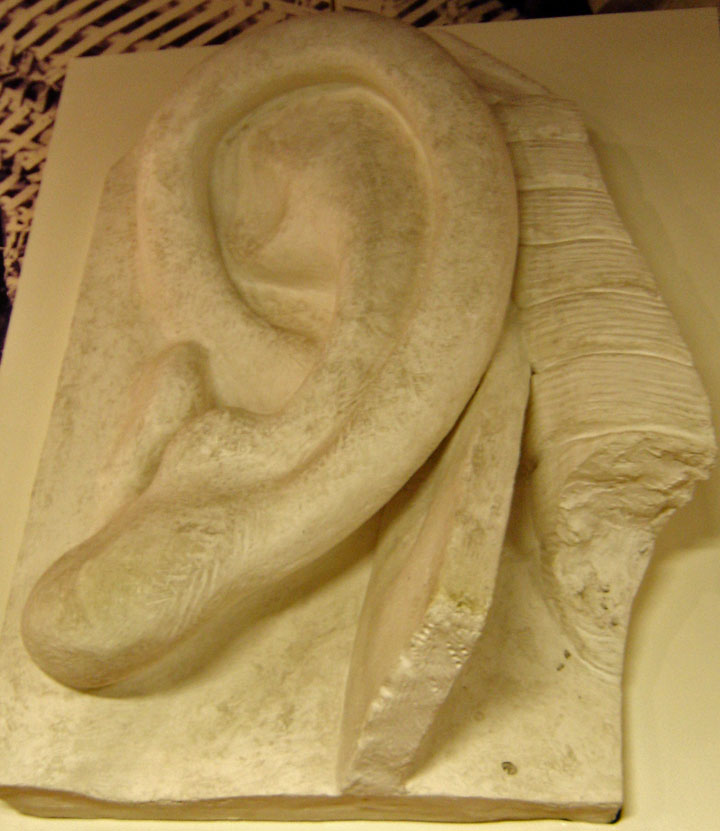
ear
In 1984, the Statue of Liberty was added to the list of World Heritage Sites. The following year, the statue was designated as an International Historic Civil Engineering Landmark by the American Society of Civil Engineers and the Société des Ingénieurs et Scientifiques de France.
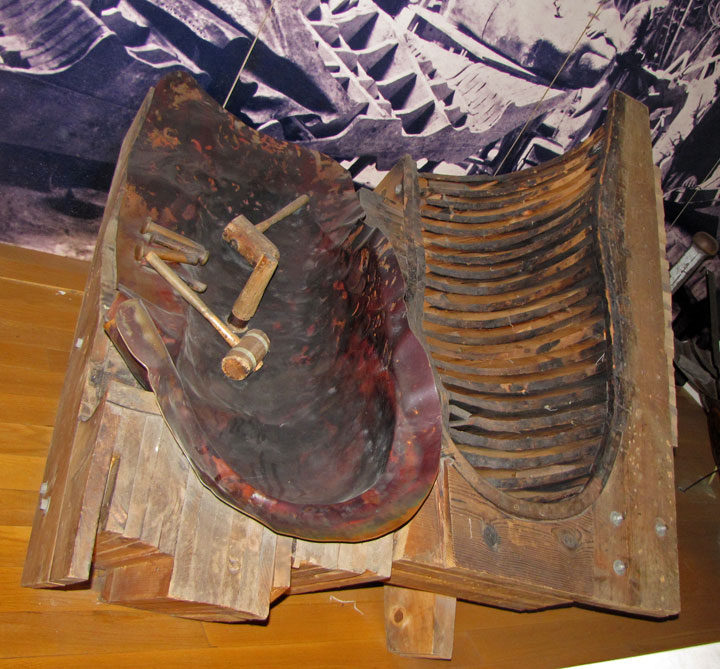
ear mold
In 2007, the Statue of Liberty was one of 20 finalists in a competition to name the New Seven Wonders of the World.
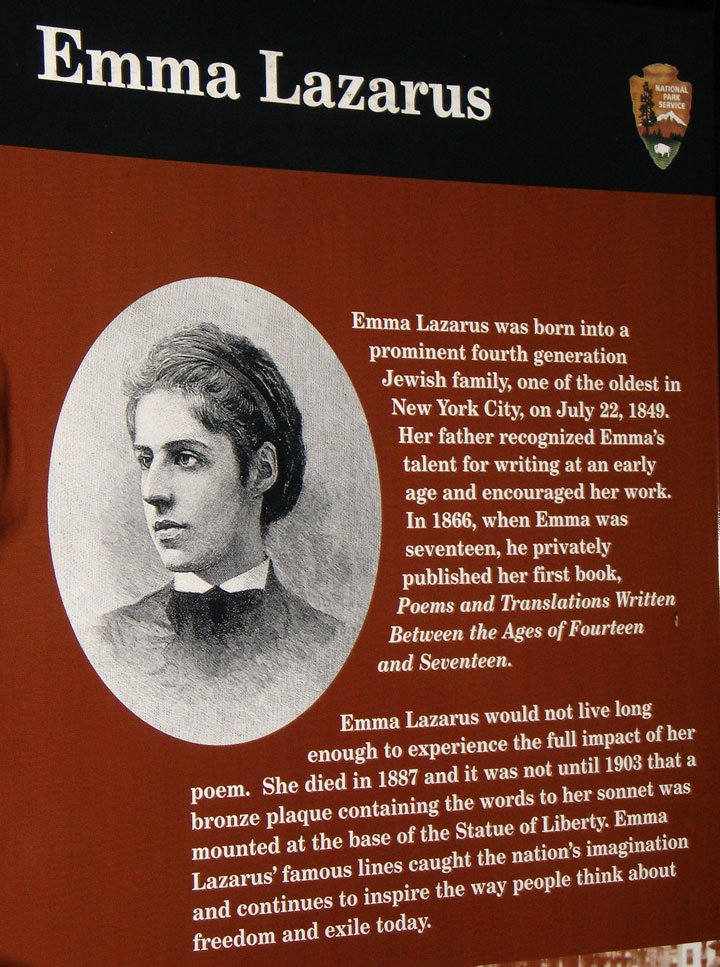
Emma Lazarus
Unsubstantiated sources cite different models for the face of the statue. One indicated the then-recently widowed Isabella Eugenie Boyer, the wife of Isaac Singer, the sewing-machine industrialist. "She was rid of the uncouth presence of her husband, who had left her with only his most socially desirable attributes: his fortune and -- his children. She was, from the beginning of her career in Paris, a well-known figure. As the good-looking French widow of an American industrialist she was called upon to be Bartholdi's model for the Statue of Liberty."
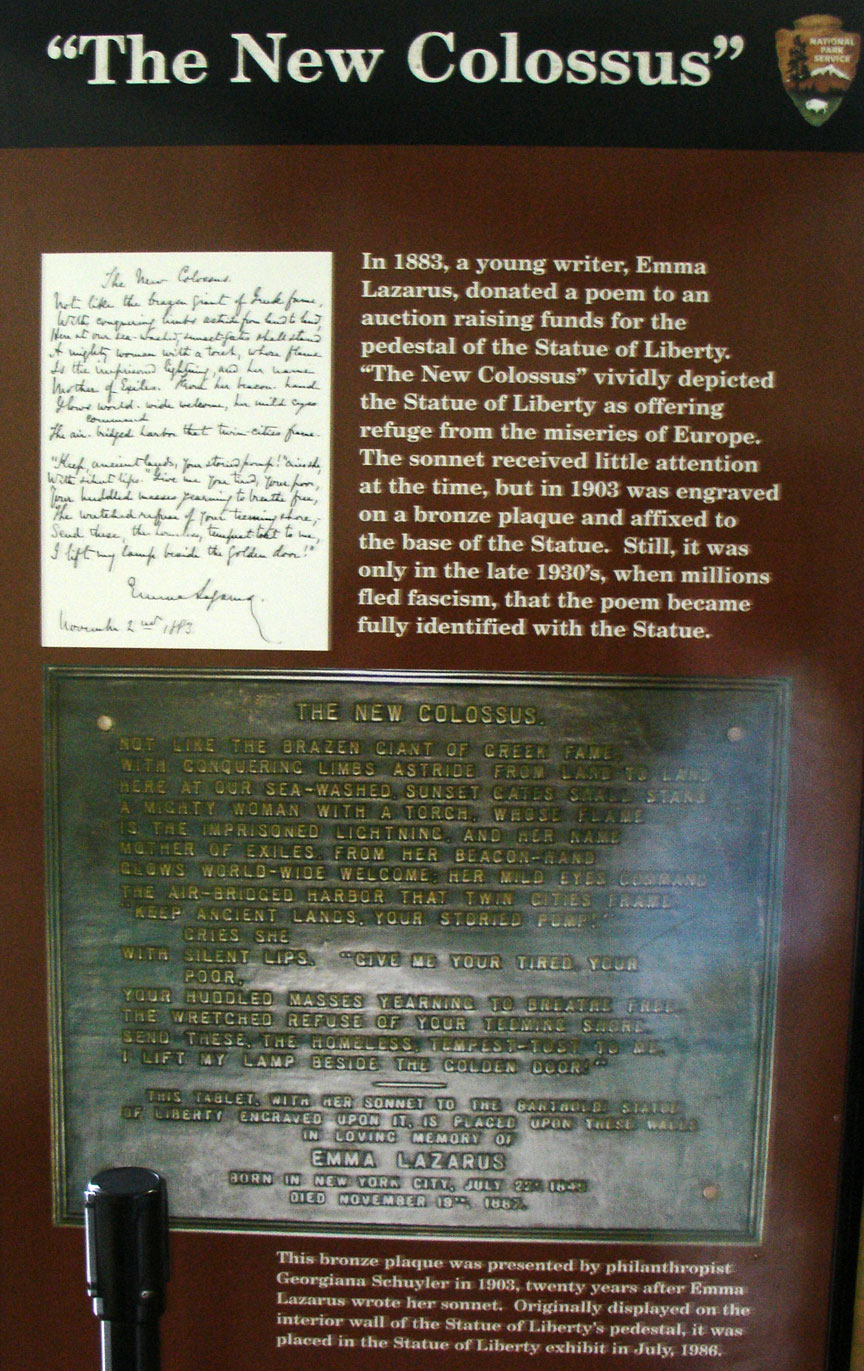
Another source believed that the "stern face" belonged to Bartholdi's mother,
Charlotte Bartholdi (1801–1891), with whom he was very close. National
Geographic magazine also pointed to his mother, noting that Bartholdi never
denied nor explained the resemblance.
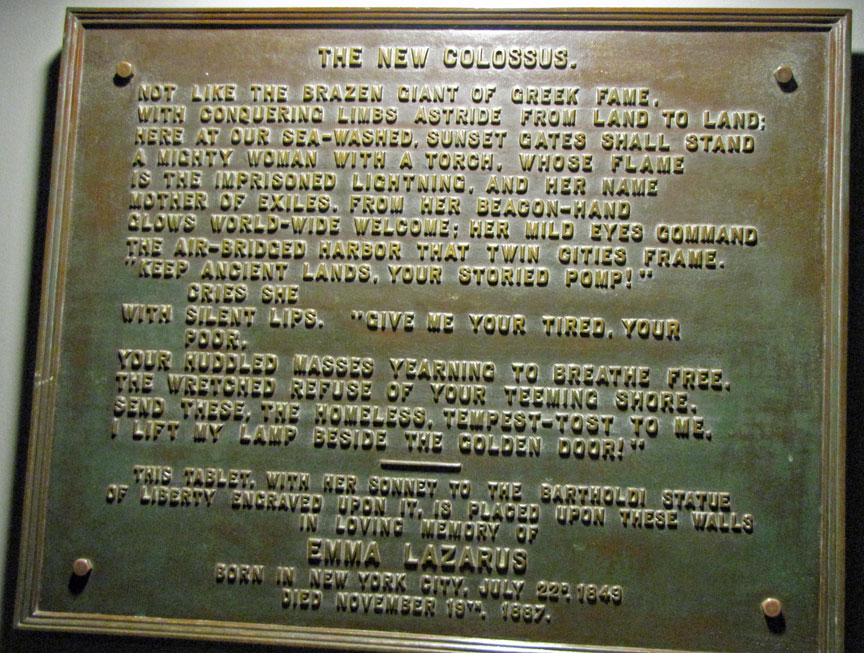
The New Colossus
The torch and the book are the attributes of Wisdom in Cesare Ripa's Iconologia (1611)
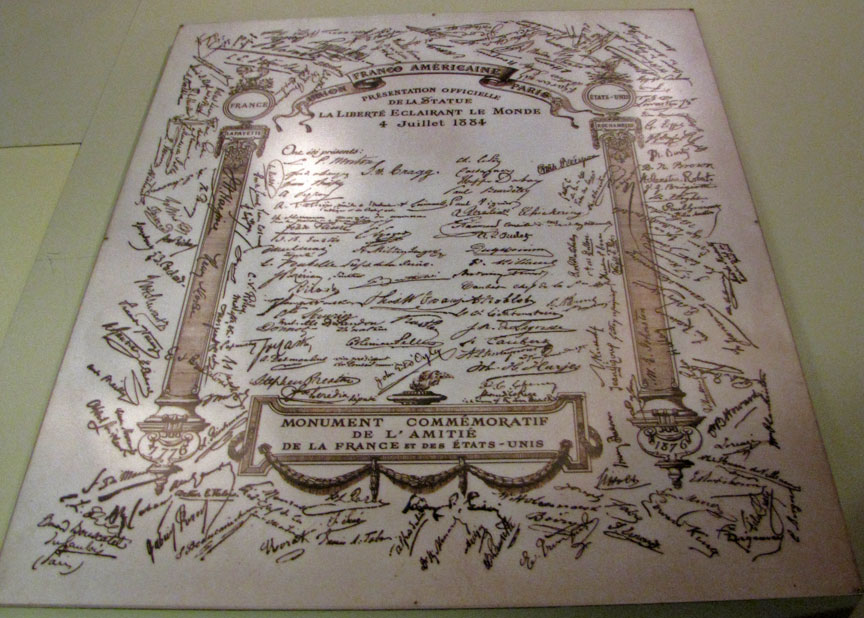
Monument Commemoratif
The classical appearance of the Statue of Liberty is based on the mythological Roman goddess Libertas, who represented liberty and freedom. The right foot is raised and her left forward as if trampling broken shackles. The torch represents enlightenment. The Keystone in her hand represents knowledge.
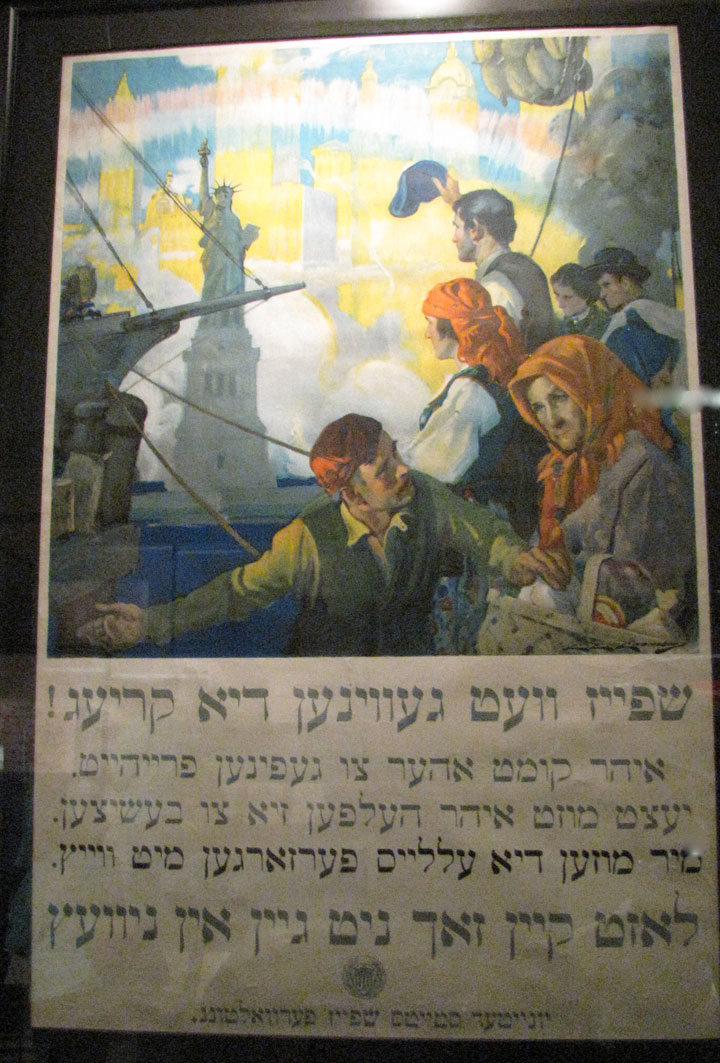
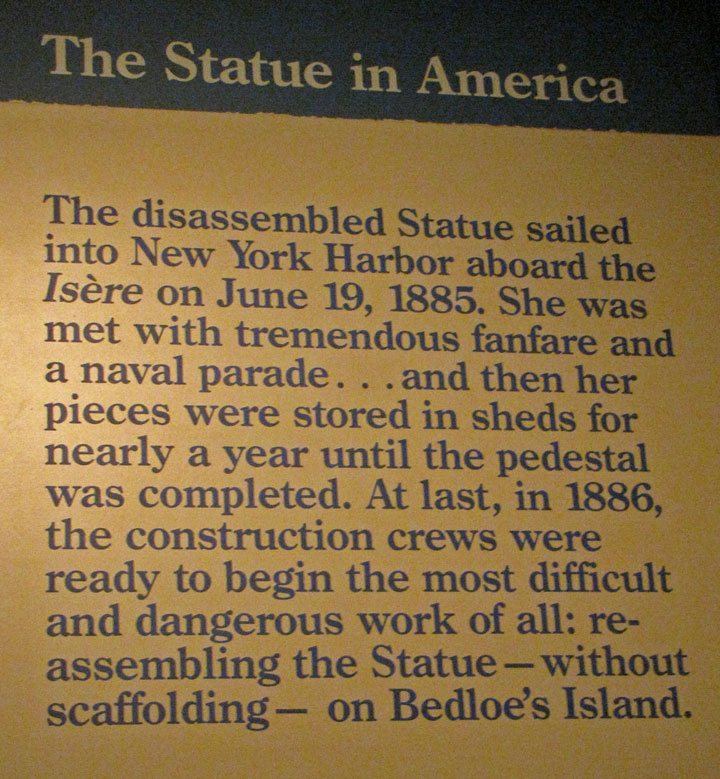
arrival in America
Libertas has been the symbol of independence, freedom as well as social justice for 2000 years. She was deified in ancient Rome in 238BC when a temple was deicated on the Aventine hill. Scholar, Selena Fox states that when a Roman slave was freed, the passage was marked with rituals using a pilleus (the cap of a freed slave) and the vindictas or rod.

the greeting parade in New York City
It is the philleus that Libertas wears and the rod that she carries in traditional Roman representations and these traditions are carried over into revolutionary, and civil wars throughout history.
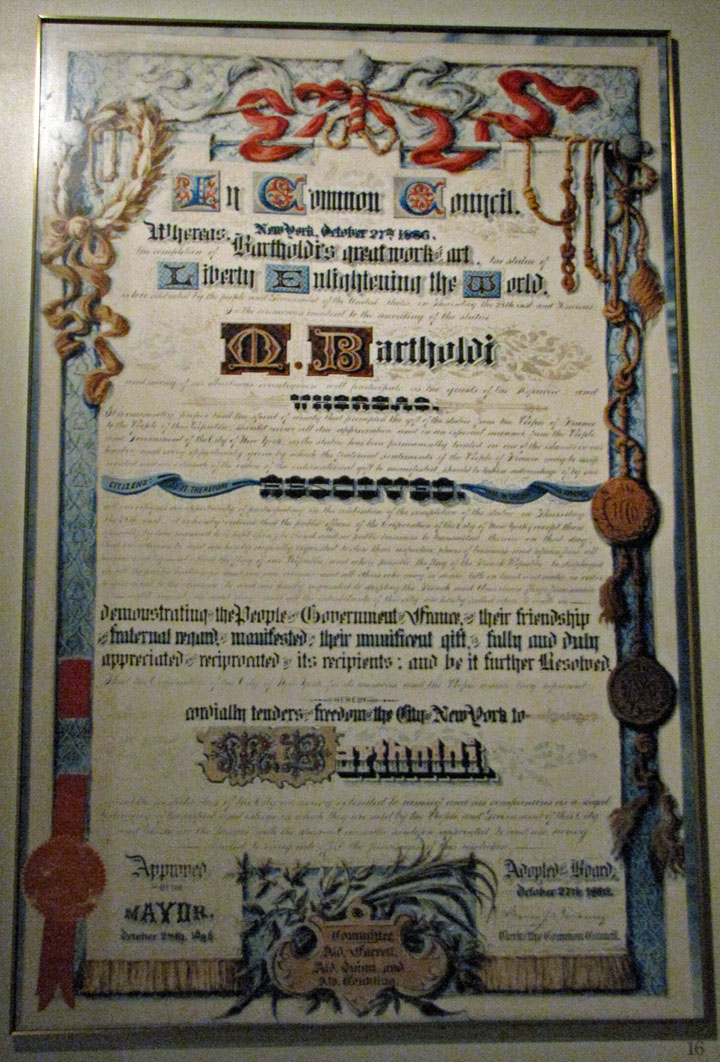
credit to Frédéric Auguste Bartholdi
In the modern era, radiant-crown-wearing allegorical statues were scuplted by Italian artists, notably Canova's' allegory of Faith on the tomb of pope Clement XIII, and Camillo Pacetti's allegory of New Testament above the entrance of Milan Cathedral.

view of Manhattan from the top of the Pedestal
They became increasingly common in
the second half of the 19th century in France and Élias Robert's France crowning
Art and Industry (1855), among others, could have provided inspiration for the
Statue of Liberty. The Great Seal of the French Second Republic (1848–1852)
displays an allegory of Liberty represented sitting and wearing a seven ray
radiant crown.
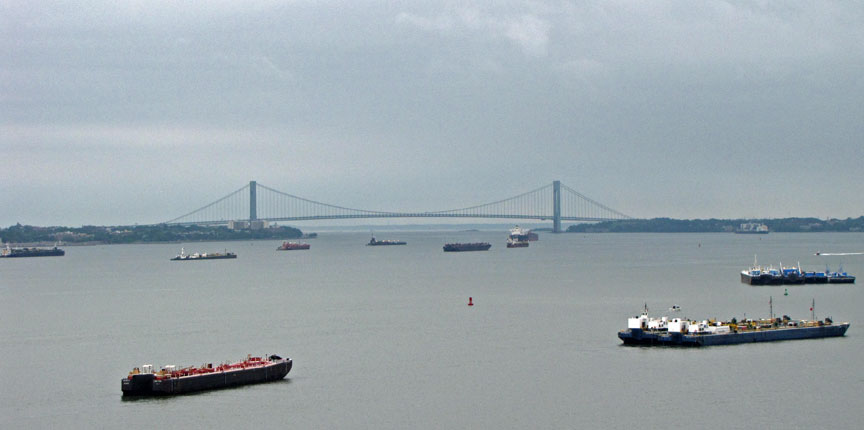
the Verrazzano bridge over the harbor narrows
The decision to depict Liberty wearing a radiant crown rather than the traditional attribute of liberty, the phrygian cap, is a negative one, avoiding what was then perceived as the symbol of radical revolutionary movements. Similarly, Thomas Crawford had to renounce to his project to dress the Capitol's Statue of Freedom with a phrygian cap because of the concern that it might be seen as an abolitionist symbol.
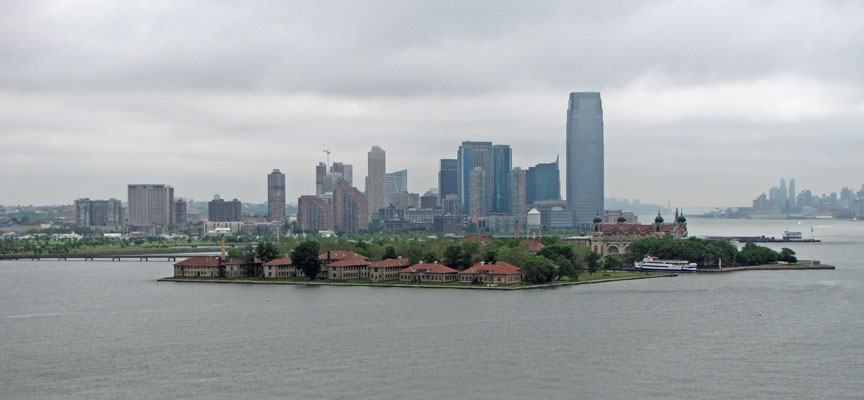
Ellis Island
The torch was first associated with Liberty in Augustin Dumont's Genius of Liberty on the July Column, a monument inaugurated in 1840. The idea of bringing light to the world was then expressed with a torch by Jean-Baptiste Carpeaux in his Imperial France bringing light to the world and protecting Agriculture and Science in 1866. An idea proposed by Hector Horeau in 1868 to build a colossus of Intelligent France enlightening the world on the Hill of Chaillot was never carried out.

view of Staten Island Ferry terminal and the Brooklyn Bridge
Except for a period of time between September 11, 2001, and July 4, 2009, the interior of the statue has been open to visitors. Visitors must purchase crown tickets in advance. Once they arrive by ferry, they must check in at the information center, then go to the base for the start of the walk up the monument. The climb to the top is 146 stairs on the double-helix stair case. Inside the copper statue it is approximately 15 to 20 degrees (F) warmer than it is outside. The NPS allows 10 people at a time with 3 groups an hour up into the crown. This provides a view of New York Harbor (the orientation of the statue faces Brooklyn) through 25 windows, the largest approximately 18" (46 cm) high. The view does not, therefore, include the skyline of Manhattan, except through the smallest windows on the left side of the crown. The wait outside regularly exceeds three hours, excluding the wait for ferries and ferry tickets.
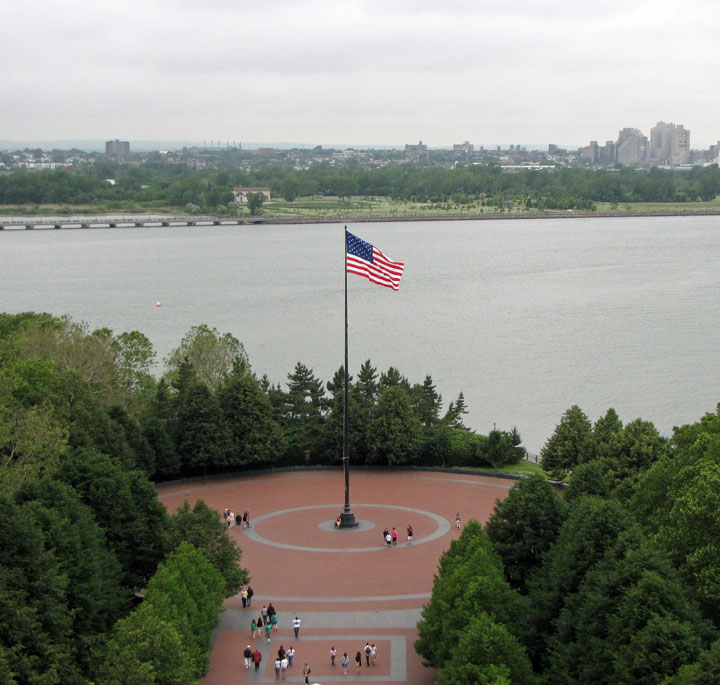
view toward New Jersey
The grey-green verdigris color is the patina which is caused by a chemical reaction and produces such copper salts as brochantite, atacamite, and antlerite, resulting in the current hue.
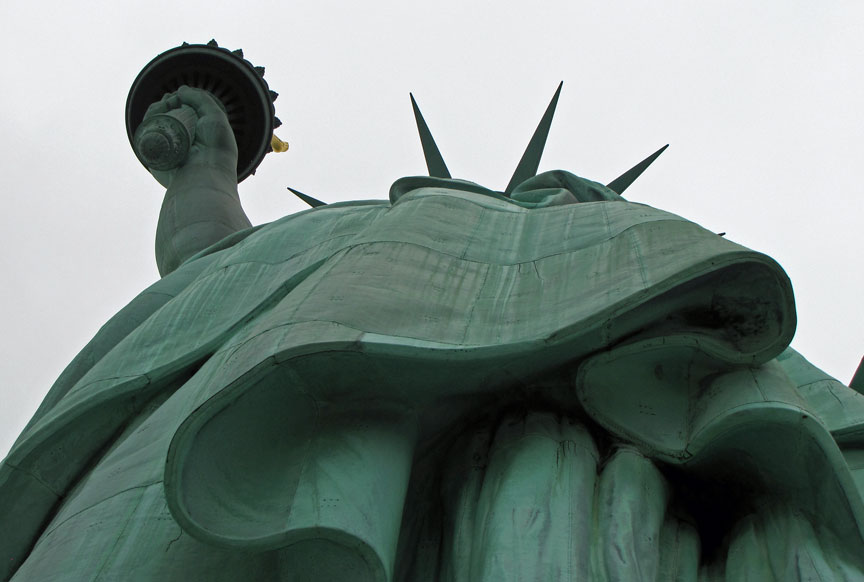
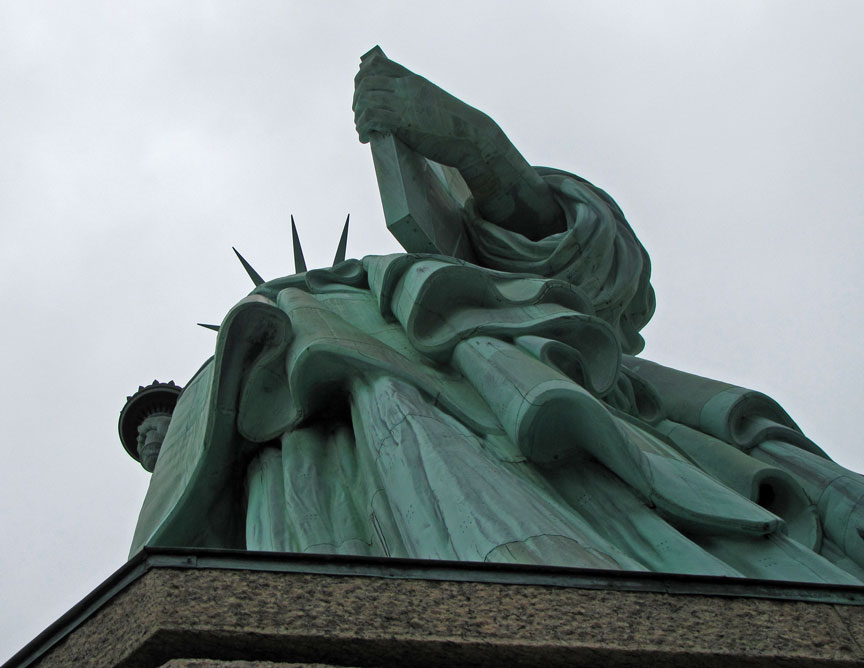
The sandstone used in the base is from Locharbriggs Quarry on the edge of
Dumfries in south west Scotland, Great Britain.
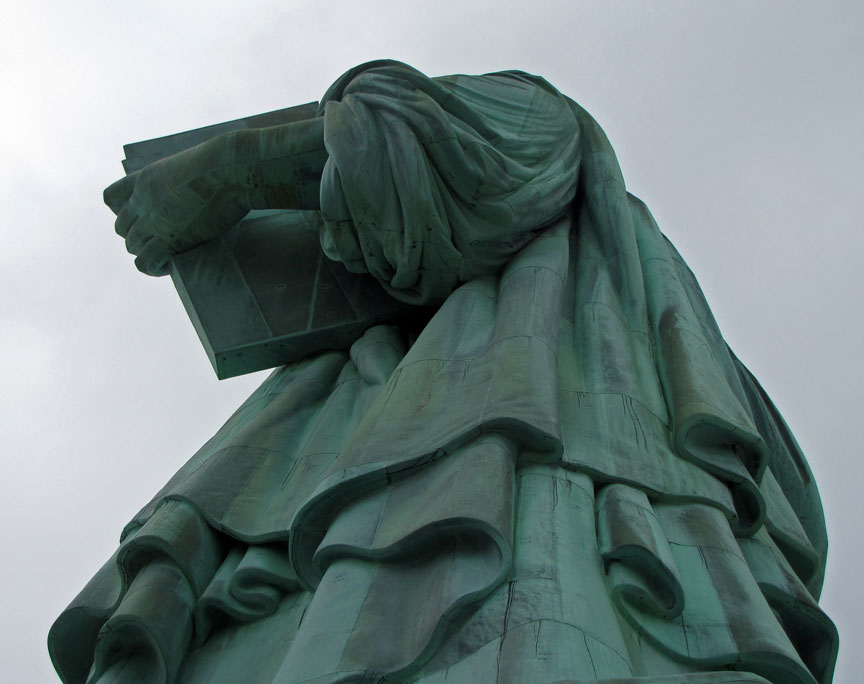
keystone in left hand
There are 354 steps inside the statue and its pedestal, with 25 windows in the crown which comprise the jewels beneath the seven rays of the diadem. The keystone which the statue holds in her left hand reads, in Roman numerals, "July 4, 1776" the day of the adoption of the Declaration of Independence.

boat arriving at Liberty Island
The Statue of Liberty was engineered to withstand heavy winds. Winds of 50 miles per hour (80 km/h) cause the Statue to sway 3 inches (76 mm) and the torch to sway 5 inches (130 mm). This allows the Statue to move rather than break in high wind load conditions.
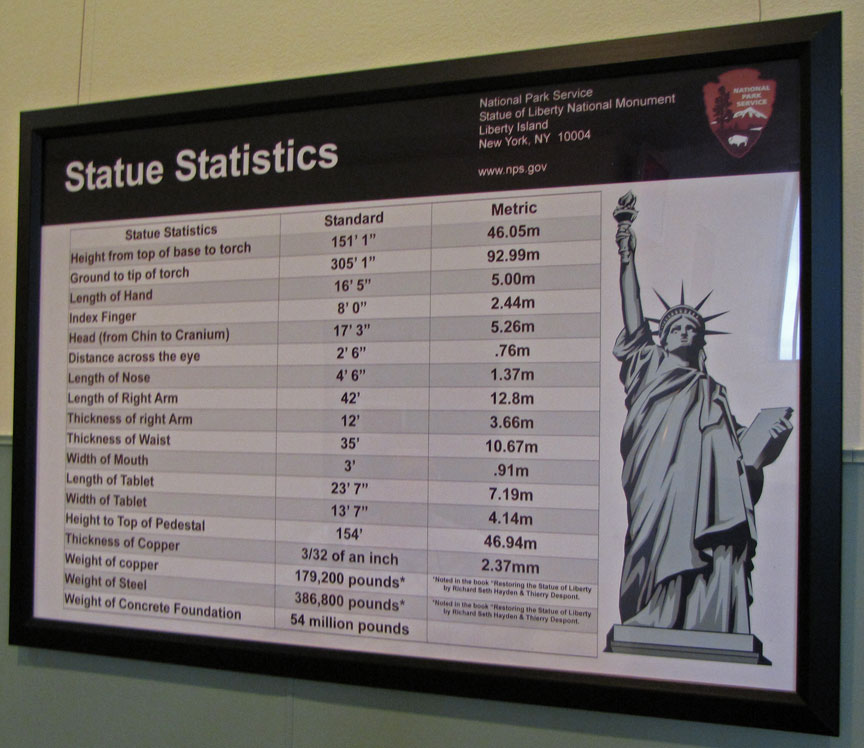
Statue Statistics
The statue is built top-heavy in order to create a slight forced perspective and appear more correctly proportioned when viewed from its base. When the statue was designed in the late 1800s (before easy air flight), there were few other angles to view the statue from.
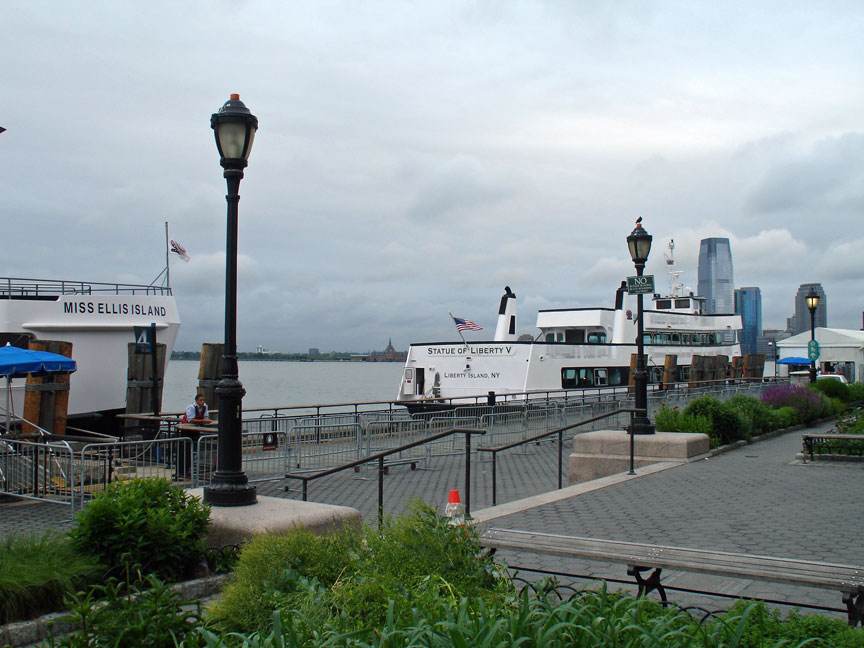
a boat from Manhattan Battery is taken to reach Liberty Island
A new torch replaced the original in
1986, which was deemed beyond repair because of the extensive 1916
modifications. The 1886 torch is now in the monument's lobby museum. The new
torch has gold plating applied to the exterior of the "flame," which is
illuminated by very large spotlights embedded in the ground surrounding the
monument.

check-in to climb to the crown
The bronze plaque in an exhibit on the second floor of the pedestal is inscribed with the sonnet "The New Colossus" by Emma Lazarus. It has never been engraved on the exterior of the pedestal, despite such depictions in editorial cartoons. The first two lines refer to the ancient Colossus of Rhodes. The bronze plaque in the pedestal contains a typographical error: the comma in "Keep, ancient lands" is missing, causing that line to read "'Keep ancient lands, your storied pomp!' cries she", and noticeably altering its meaning. The name "Mother of Exiles" was never taken up as the statue's name.
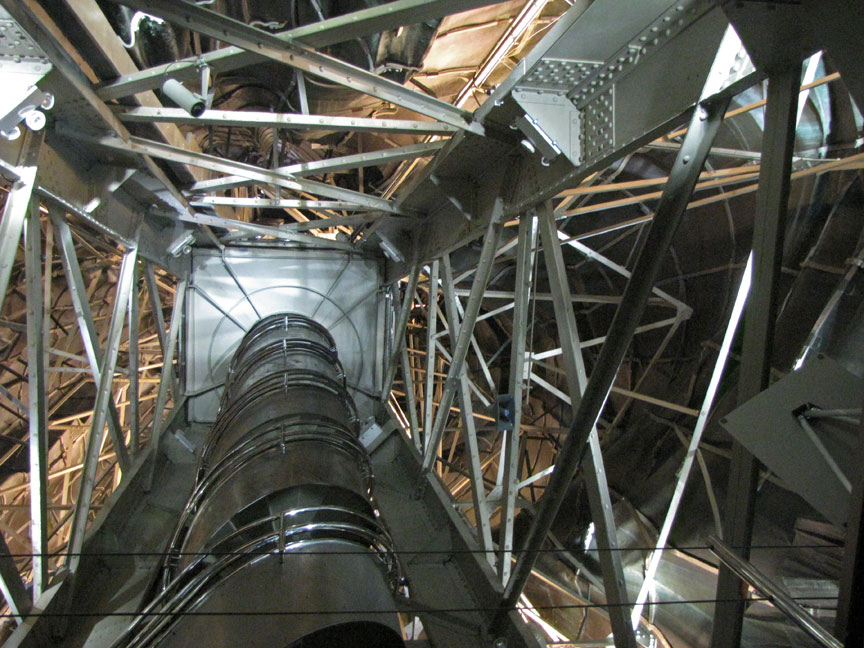
internal stairway to the crown
Liberty Island has been the property
of the United States government since 1800, and until 1944 served as a military
installation called Fort Wood. It has been operated by the National Park Service
since 1937. The built portions of Liberty Island (as well as 3 acres of nearby
Ellis Island) are under the jurisdiction and are part of New York City. They are
bounded completely by the municipal borders of Jersey City, New Jersey, which
retains riparian rights to all its portions of the Hudson River and the Upper
New York Bay. Historical circumstances have led to the unusual situation of
Liberty Island being an exclave of one state, New York, located completely
within another, New Jersey. The dominion of the island has variously been a
subject of (or directly affected by) a land grant, a government directive, an
interstate compact as well as several court cases and US Supreme Court
decisions.
The Statue of Liberty was one of the earliest beneficiaries of a cause marketing
campaign.
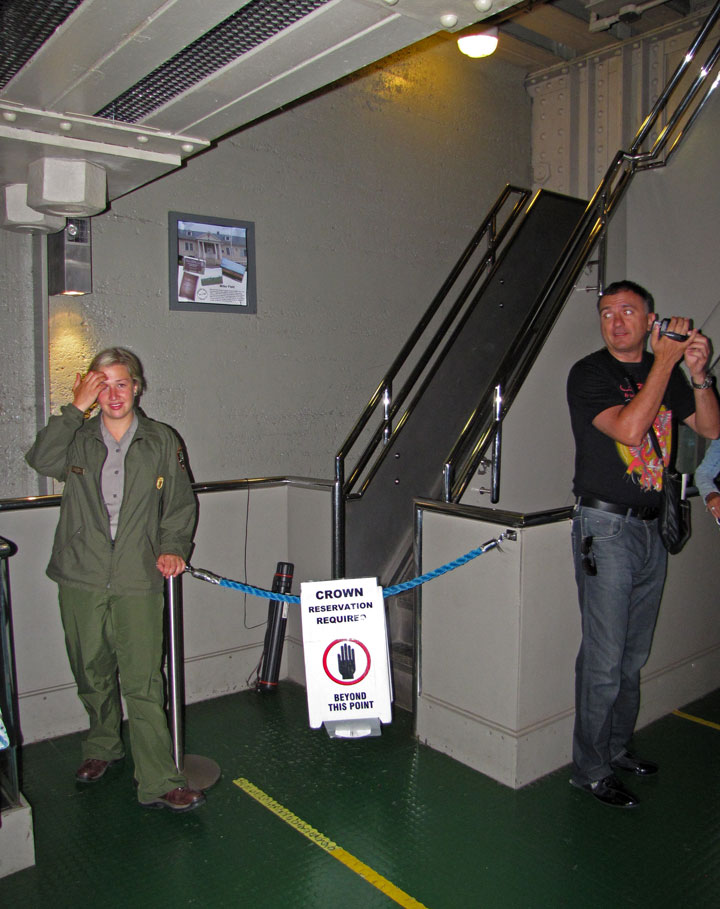
the climb starts here
A 1983 promotion advertised that for each purchase made with an American Express card, American Express would contribute one penny to the renovation of the statue. The campaign generated contributions of $1.7 million to the Statue of Liberty restoration project. In 1984, the statue was closed so that a $62 million renovation could be performed for the statue's centennial. Chrysler chairman Lee Iacocca was appointed by President Reagan to head the commission overseeing the task (but was later dismissed "to avoid any question of conflict" of interest) and republican fundraiser Wyatt A. Stewart ran the huge grassroots fundraising campaign.[75] Workers erected scaffolding around the statue, obscuring it from public view until the rededication on July 3, 1986—the scaffolding-clad statue can be seen in the 1984 film Desperately Seeking Susan, in the 1985 film Remo Williams: The Adventure Begins, in the 1985 film Brewster's Millions, and on the cover of the 1986 Jackson Browne album Lives in the Balance. Inside work began with workers using liquid nitrogen to remove seven layers of paint applied to the interior of the copper skin over the decades. That left two layers of coal tar originally applied to plug leaks and prevent corrosion. Blasting with baking soda powder removed the tar without further damaging the copper. Larger holes in the copper skin were repaired with the addition of an inner lip upon which new copper patches were inset, riveted, and hammered flush.
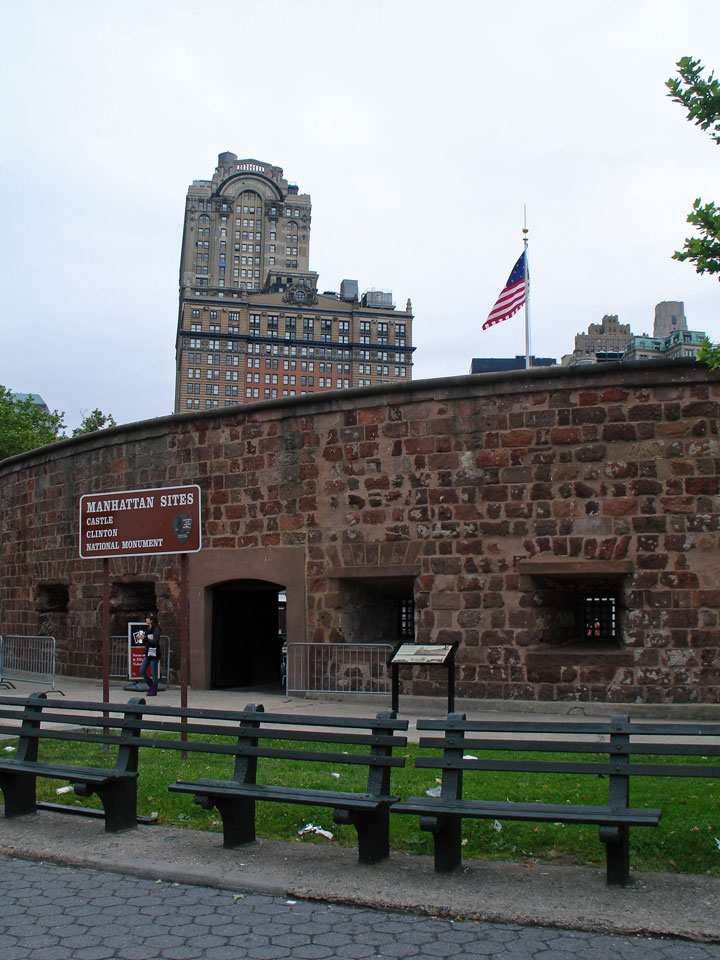
Castle Clinton
Manhattan, Battery
Each of the 1,350 shaped iron ribs backing the skin had to be removed and replaced. The iron had experienced galvanic corrosion wherever it contacted the copper skin, losing up to 50% of its thickness. Bartholdi had anticipated the problem and used an asbestos/pitch combination to separate the metals, but the insulation had worn away decades before. New bars of stainless steel bent into matching shapes replaced the iron bars, with Teflon film separating them from the skin for further insulation and friction reduction.
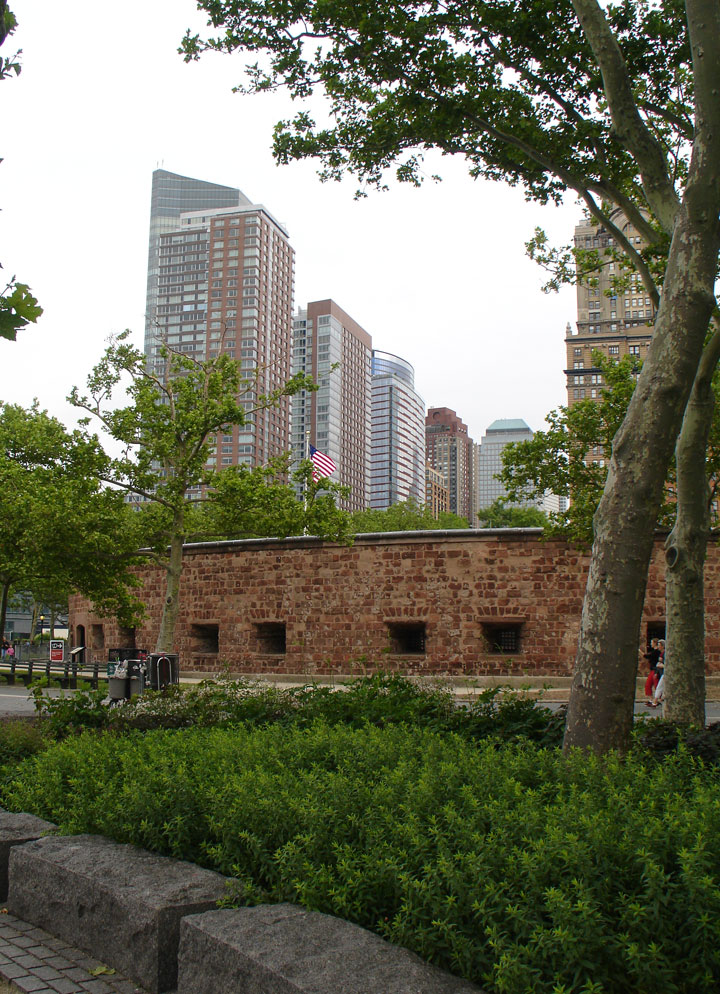
The internal structure of the upraised right arm was reworked. The statue was
erected with the arm offset 18" (0.46 m) to the right and forward of Eiffel's
central frame, while the head was offset 24" (0.61 m) to the left, which had
been compromising the framework. Theory held that Bartholdi made the
modification without Eiffel's involvement after seeing the arm and head were too
close. Engineers considered reinforcements made in 1932 insufficient and added
diagonal bracing in 1984 and 1986 to make the arm structurally sound.
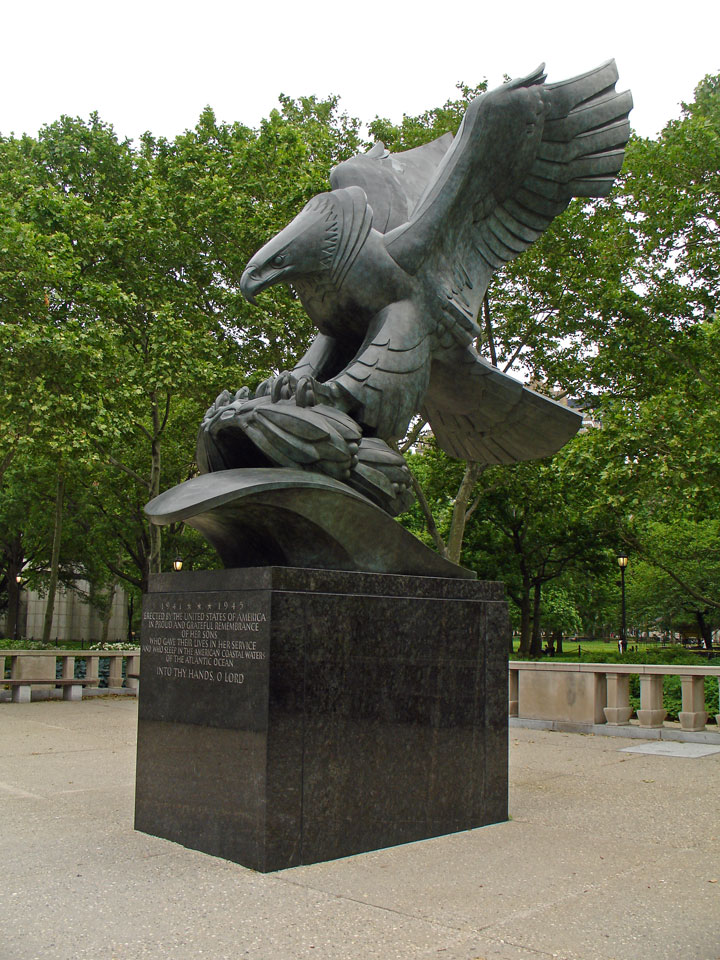
the Eagle
favorite meeting point in the Battery
Besides the replacement of much of the internal iron with stainless steel and the structural reinforcement of the statue itself, the restoration of the mid-1980s also included the replacement of the original torch with a replica, replacing the original iron stairs with new stairs, installing a newer elevator within the pedestal, and upgrading climate control systems. The Statue of Liberty was reopened to the public on July 5, 1986.
Text from Wikipedia